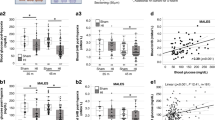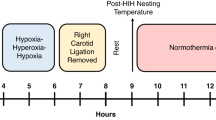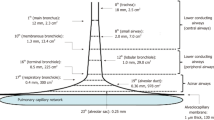Abstract
The effect of hyperglycemia on ischemic brain damage was investigated in a newborn dog model of hypothermic circulatory arrest. Newborn dogs were anesthetized with halothane, paralyzed, and artificially ventilated to maintain normoxia and acidbase balance. Animals were surface-cooled to 20°C, after which cardiac arrest was effected with i.v. KCl. Before surface cooling, one-half of the dogs (n = 12) received a bolus injection of 50% glucose to increase plasma glucose concentrations to approximately 33 mmol/L (600 mg/dL); control littermates (n = 12) received an equivalent volume of 1 N saline. The dogs remained asystolic for 1.75 h, after which cardiopulmonary resuscitation was accomplished. All animals survived, were allowed to recover from anesthesia at 37°C, and were maintained for 8 h of recovery, at which interval they underwent perfusion-fixation of their brains for pathologic analysis. Histologic grading of brain damage showed no statistically significant difference in the severity of neuronal necrosis within the cerebral cortex or caudate nucleus between hyperglycemic and normoglycemic littermates, with greater brain damage apparent in the amygdaloid nucleus of the hyperglycemic dogs (p < 0.02). Brainstem injury occurred more frequently in the hyperglycemic animals(p < 0.05). Correlation of coefficients analyses revealed a positive correlation between the severity of brain damage and plasma glucose concentration for both the caudate nucleus and amygdaloid nucleus but not for the cerebral cortex. The findings suggest that hyperglycemia superimposed upon hypothermic circulatory arrest in the newborn dog accentuates brain damage only in selected regions of the brain, especially the caudate and amygdaloid nuclei and brainstem, excluding the cerebral cortex.
Similar content being viewed by others
Log in or create a free account to read this content
Gain free access to this article, as well as selected content from this journal and more on nature.com
or
Abbreviations
- MABP:
-
mean arterial blood pressure
- Paco2:
-
partial pressure of arterial CO2
- Pao2:
-
partial pressure of arterial O2
- pHa:
-
arterial pH
References
Ferry PC 1987 Neurologic sequelae of cardiac surgery in children. Am J Dis Child 141: 309–312
Greeley WJ, Ungerleider RM, Smith LR, Reeves JG 1989 The effects of deep hypothermic cardiopulmonary bypass and total circulatory arrest on cerebral blood flow in infants and children. Thorac Cardiovasc Surg 97: 737–745
Sealy WC 1989 Hypothermia: its possible role in cardiac surgery. Ann Thorac Surg 47: 788–791
Stevenson JG, Stone EF, Dillard DH 1974 Intellectual development of children subjected to prolonged circulatory arrest during hypothermic open heart surgery in infancy. Circulation 49: 54–59
Dickinson DF, Sambrooks JE 1979 Intellectual performance in children after circulatory arrest with profound hypothermia in infancy. Arch Dis Child 54: 1–6
Wells FC, Coghill S, Caplan HL 1983 Duration of circulatory arrest does influence the psychological development of children after cardiac operations in early life. J Thorac Cardiovasc Surg 86: 823–831
Brunberg JA, Reilly EL, Doty DB 1974 Central nervous system consequences in infants of cardiac surgery using deep hypothermia and circulatory arrest. J Cardiovasc Surg 49: 60–68
Myers RE, Yamaguchi S 1977 Nervous system effects of cardiac arrest in monkeys. Preservation of vision. Arch Neurol 34: 65–74
Pulsinelli WA, Waldman S, Rawlinson D, Plum F 1982 Hyperglycemia converts neuronal damage into brain infarction. Neurology 32: 1239–1246
Kalimo H, Rehncrona S, Soderfeldt B, Olsson Y, Siesjo BK 1981 Brain lactic acidosis and ischemic cell damage. 2. Histopathology. J Cereb Blood Flow Metab 1: 313–327
Pulsinelli WA, Levy DE, Sigsbee B, Scherer P, Plum F 1983 Increased damage after ischemic stroke in patients with hyperglycemia with or without diabetes mellitus. Am J Med 74: 540–544
Palmer C, Vannucci RC, Christensen MA, Brucklacher RM 1989 Regional cerebral blood flow and glucose utilization during hypothermia in newborn dogs. Anesthesiology 71: 730–737
Mujsce DJ, Towfighi J, Yager JY, Vannucci RC 1993 Neuropathologic aspects of hypothermic circulatory arrest in newborn dogs. Acta Neuropathol 85: 190–198
Mujsce DJ, Towfighi J, Heitjan DF, Vannucci RC 1994 Differences in intra-ischemic temperature influenced neurological outcome after deep hypothermic circulatory arrest in newborn dogs. Stroke 25: 1433–1442
Mujsce DJ, Towfighi J, Vannucci RC 1990 Physiologic and neuropathologic aspects of hypothermic circulatory arrest in newborn dogs. Pediatr Res 28: 354–360
Newburger JW, Jonas RA, Wernovsky G, Wypij D, Hickey PR, Kuban KCK, Farrell DM, Holmes GL, Helmers SL, Constantinou J, Carrazana E, Barlow JK, Walsh AZ, Lucius KC, Share JC, Wessel DL, Hanley FL, Mayer JE, Castaneda AR, Ware JH 1993 A comparison of the perioperative neurologic effects of hypothermic circulatory arrest versus low-flow cardiopulmonary bypass in infant heart surgery. N Engl J Med 329: 1057–1064
Miller G, Rodichok LD, Baylen BG, Myers JL 1994 EEG changes during open heart surgery on infants aged 6 months or less: relationship to early neurologic morbidity. Pediatr Neurol 10: 124–130
Rogers BT, Msall ME, Buck GM, Lyon NR, Norris MK, Roland J-MA, Gingell RL, Clevland DC, Pieroni DR 1995 Neurodevelopmental outcome of infants with hypoplastic left heart syndrome. J Pediatr 126: 496–498
Glauser TA, Rorke LB, Weinberg PM, Clancy RR 1990 Acquired neuropathologic lesions associated with the hypoplastic left heart syndrome. Pediatrics 85: 991–1000
Vannucci RC, Mujsce DJ 1992 Effect of glucose on perinatal hypoxic-ischemic brain damage. Biol Neonate 62: 215–224
Hattori H, Wasterlain CG 1990 Posthypoxic glucose supplementation reduces hypoxic-ischemic brain damage in the neonatal rat. Ann Neurol 28: 122–128
Hope PL, Cady EB, Delpy DT, Ives NK, Gardiner RM, Reynolds EOR 1988 Brain metabolism and intracellular pH during ischemia: Effects of systemic glucose and bicarbonate administration studied by31 P and 1H nuclear magnetic resonance spectroscopy in vivo in the lamb. J Neurochem 50: 1394–1402
Chao CR, Hohimer AR, Vissonnette JM 1989 The effect of elevated blood glucose on the electroencephalogram and cerebral metabolism during short-term brain ischemia in fetal sheep. Am J Obstet Gynecol 161: 221–228
Rosenberg AA, Murdaugh E 1990 The effect of blood glucose concentration on postasphyxia cerebral hemodynamics in newborn lambs. Pediatr Res 27: 454–459
Young RSK, Petroff OAC, Aquila WJ, Chueng A, Gore JC 1991 Hyperglycemia and the rate of lactic acid accumulation during cerebral ischemia in developing animals: in vivo proton MRS study. Biol Neonate 59: 136–142
LeBlanc MH, Huang M, Vig V, Patel D, Smith EE 1993 Glucose affects the severity of hypoxic-ischemic brain injury in newborn pigs. Stroke 24: 1055–1062
Rehncrona S, Rosen I, Siesjo BK 1980 Excessive cellular acidosis: an important mechanism of neuronal damage in the brain?. Acta Physiol Scand 110: 435–437
Welsh FA, Ginsberg MD, Reider W, Budd WW 1980 Deleterious effect of glucose pretreatment on recovery from diffuse cerebral ischemia in the eat. II. Regional metabolic levels. Stroke 11: 355–363
Pulsinelli WA, French J, Rawlinson D, Plum F 1982 Cerebral ischemia damages neurons despite lowered brain lactate levels. Ann Neurol 12: 86
Cremer JE 1982 Substrate utilization and brain development. J Cereb Blood Flow Metab 2: 394–407
Busto R, Dietrich WD, Globus MY-T, Valdes I, Schenberg P, Ginsberg MD 1987 Small differences in intra-ischemic brain temperature critically determine the extent of ischemic neuronal injury. J Cereb Blood Flow Metab 7: 729–738
Ridenour TR, Warner DS, Todd MM, McAllister AC 1992 Mild hypothermia reduces infarct size resulting from temporary but not permanent focal ischemia in rats. Stroke 23: 733–738
Yager J, Towfighi J, Vannucci RC 1993 Influence of mild hypothermia on hypoxic-ischemic brain damage in the immature rat. Pediatr Res 34: 525–529
Acknowledgements
The authors thank the following individuals for their excellent technical assistance: Robert M. Brucklacher, B.S., Cathy M. Housman, B.S., and Lisa Seaman, B.S.
Author information
Authors and Affiliations
Additional information
Supported by the National Institute of Child Health and Human Development Grant P01 HD30704.
Rights and permissions
About this article
Cite this article
Vannucci, R., Rossini, A. & Towfighi, J. Effect of Hyperglycemia on Ischemic Brain Damage during Hypothermic Circulatory Arrest in Newborn Dogs. Pediatr Res 40, 177–184 (1996). https://doi.org/10.1203/00006450-199608000-00001
Received:
Accepted:
Issue date:
DOI: https://doi.org/10.1203/00006450-199608000-00001
This article is cited by
-
Give me less sugar: how to manage glucose levels in post-anoxic injury?
Intensive Care Medicine (2014)
-
Emergency Preservation and Resuscitation with Profound Hypothermia, Oxygen, and Glucose Allows Reliable Neurological Recovery after 3 h of Cardiac Arrest from Rapid Exsanguination in Dogs
Journal of Cerebral Blood Flow & Metabolism (2008)



